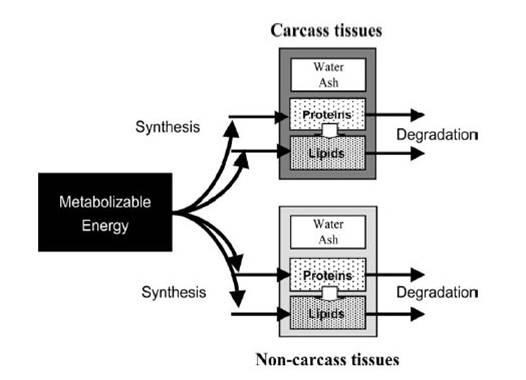
Based on a mechanistic and dynamic model, the NDS Beef Growth Model was designed and constructed to simulate beef cattle growth and related body composition for different animal types under various nutritional conditions. It represents a useful approach and enhancement in our understanding to Beef Cattle feeding.
This model takes into account major processes involved in the evolution of body composition. It considers proteins and lipids in carcass and non-carcass tissues, which led to a total of four state variables and differential equations. The evolution of these state variables is controlled by synthesis and degradation processes, and depends on the physiological age of the animals and on energy supply to be metabolized. Empty and full body weights are deduced from protein and lipid contents through allometric equations.
NDS Beef Growth Model is integrated in the NDS Professional platform and it is available through the recipe screen for Beef Cattle animal type.
Structure of the model
The model is constructed on the basis of variations of body protein and lipid contents. Ruminant non-carcass tissues, which comprise viscera, are associated with a greater metabolic activity, i.e. higher energy metabolism than the carcass. The model thus makes a distinction between proteins in body and viscera. In addition, it separates carcass and non-carcass lipids to allow the simulation of the whole carcass growth and composition, which is of economic and practical interest.

The chemical composition of the tissues is described by a compartments sub-system. It considers six compartments: proteins, lipids and water plus ash, both for the carcass and non-carcass.
The evolution of these six compartments is regulated by flows of entry and exit as opposed metabolic activity, corresponding respectively to the processes of synthesis (anabolism), influenced by the energy supply (ME Mcal/day), and degradation (catabolism).
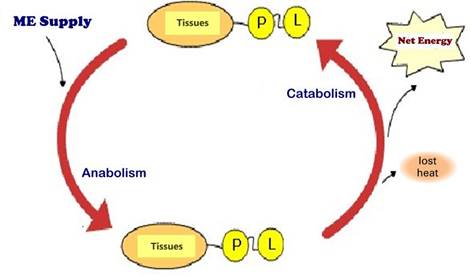
The weight evolution of the different compartments depends on their different response to the ME available, besides the physiological age of the animals.
The Metabolizable Energy available, estimated by the CNCPS Model, presides over the evolution of the different variables and, therefore, constitute the driving force of the model. In other words, it relates the ME provided with the Net Energy retained in tissues in the form of proteins and lipids, while the influence of protein supply on cattle growth is not taken into account in this version of the model.
NDS Beef Growth Model aims at representing the response of protein and lipid compartments to ME supply, in order to study the evolution of body composition. In addition, for the sake of simplicity, only the post-weaning period is considered. We thus can simulate the growth of an animal from weaning to adult stage.
Anabolic implant effects
It has been well recognized for long time that anabolic implants improve growth rate, feed conversion, and protein deposition in cattle under both experimental and commercial conditions. The use of anabolic implants has also resulted in increased carcass weight and increased carcass muscle yield in cattle.
It is not easy to model the anabolic implants effects because of the variety of available products (estrogen, androgen, combination) and the different responses due to the genetic variability of the animals.
However, NDS Beef Growth Model has introduced some adjustment factors for the average daily gain expected and tissues composition, in order to get predictions that are more accurate. This approach can certainly be improved, and it represents a first step towards a more robust modeling of these effects.
Performance projections
In addition to the ability to predict the performance now, NDS Beef Growth Model may carry out assessments for a given growth period, providing more accurate evaluations about the expectations of growth at the end of the cycle.
These projections are shown graphically and are related to:
Average Daily Gain
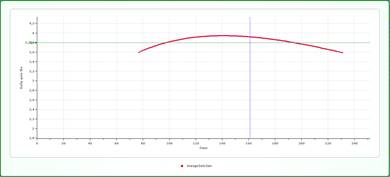
Body weight and composition
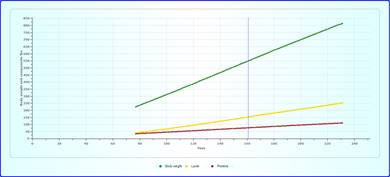
DMI and ME Intake
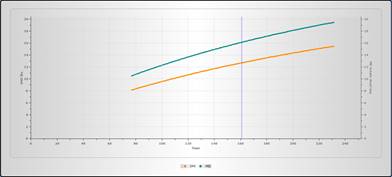
Output and predictions
The utilization of the BGM is very simple because it works in the background during the ration formulation for Beef and it uses the inputs already provided for the CNCPS model. It is invoked by opening the specific tab.

The whole output screen is like the example below:
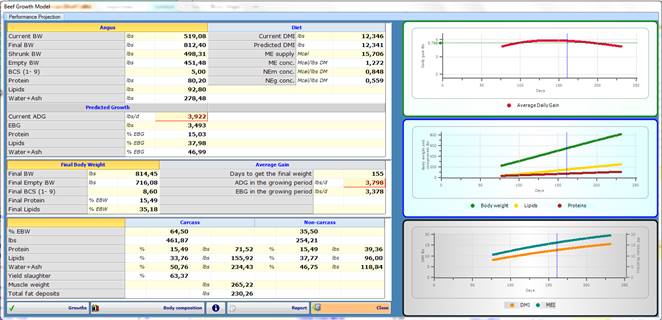
Different sections describe in detail the several information used or generated by the model:
- Description of the animal at the beginning of the growth period;
- Main parameters for the current diet;
- Predicted growth at the current time;
- Final body weight and composition;
- Average daily gain expected for the whole growth period;
- Final Carcass and Non-carcass weight and composition.
The present model should allow:
- Simulate the response of an animal to a given energy supply;
- Eevaluate the anabolic implants effects;
- Predict when a group of animals reach a desired slaughter weight;
- Define the growth needed to achieve a desired weight and the related energy supply;
- Assist in management and economic assessments.
References
Thierry Hoch, Jacques Agabriel, 2004. A mechanistic dynamic model to estimate beef cattle growth and body composition: 1. Model description. Agricultural Systems 81 (2004) 1–15
Thierry Hoch, Jacques Agabriel, 2004. A mechanistic dynamic model to estimate beef cattle growth and body composition: 2. Model evaluation. Agricultural Systems 81 (2004) 17–35
T. Hoch, P. Pradel, J. Agabriel, 2004. Modélisation de la croissance de bovins : evolution des modèles et applications. INRA Prod. Anim.,2004,17 (4), 303-314
F. Garcia, R.D. Sainz, J. Agabriel, L.G. Barioni, J.W. Oltjen, 2008. Comparative analysis of two dynamic mechanistic models of beef cattle growth. Animal Feed Science and Technology 143 (2008) 220–241
Rigot F., Cabon G., Garcia F., Micol D., Agabriel J., 2009. Construction d’un simulateur de croissance des jeunes bovins en engraissement. Renc. Rech. Ruminants, 2009, 16, 41-44
C. D. Reinhardt and J. J. Wagner, 2014. High-dose anabolic implants are not all the same for growth and carcass traits of feedlot steers: A meta-analysis. J. ANIM. SCI. 2014, 92:4711-4718
J. P. Hutcheson, D. E. Johnson, C. L. Gerken, J. B. Morgan and J. D. Tatum, 1997. Anabolic implant effects on visceral organ mass, chemical body composition, and estimated energetic efficiency in cloned (genetically identical) beef steers. J. ANIM. SCI. 1997, 75:2620-2626.